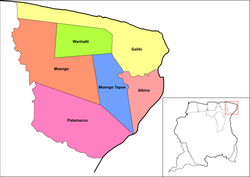Wanhatti is a village and resort in Suriname, located in the Marowijne district on the Cottica River.[2] The resort is inhabited by the Ndyuka Maroons, and has a population of 468 people as of 2012.[1] The village is primarily inhabited by Ndyuka of the Ansu clan or lo.[3]
Wanhatti | |
|---|---|
 Wanhatti (1896) | |
 Map showing the resorts of Marowijne District. Wanhatti | |
| Coordinates: 5°46′59″N 54°27′22″W / 5.78306°N 54.45611°W | |
| Country | |
| District | Marowijne District |
| Area | |
| • Total | 461 km2 (178 sq mi) |
| Elevation | 0 m (0 ft) |
| Population (2012) | |
| • Total | 468 |
| • Density | 1.0/km2 (2.6/sq mi) |
| Time zone | UTC-3 (AST) |
Name edit
Wanhatti means "one heart" in both Sranan Tongo and Ndyuka and refers to the fact that the village is a merger of the villages of Agiti Ondoo and Walimbumofu.[4][3]
History edit
Agiti Ondoo was the site of a Gaan Gadu shrine.[5]
In 1972, a road was built to connect Wanhatti to the East-West Link. The road partially uses the path of the old defence line,[6] build between 1770 and 1778 to protect the plantations of the Colony of Suriname against attacks by the Maroons.[7] The road improved conditions in the village, and it now has a school, and a connection to the telephone network.[6] The Surinamese Interior War fought during the 1980s left its toll on the resort, and caused a large part of the population to flee.[8] In September 2010, a health care clinic was opened in the village.[9] In 2011, the road was extended to reach the village Lantiwee,[6] and it is hoped that this will lead to a return of farmers in the area.[10] On 3 June 2011, a library was opened in the village.[11]
Besides Wanhatti itself, the resort contains among others the villages of Lantiwee, Pikin Santi, Pinatjaimi, and Tamarin.
Aluku Maroons edit
Fort Buku, a famous Aluku Maroon fort of the Boni War that fell in 1772, is located within the Wanhatti resort, however the fort itself still has to be discovered as of 2020.[12] The Ndyuka signed a peace treaty in 1760.[13] Boni also desired a peace treaty, but the Society of Suriname, despite contrary advice from the Dutch government, wanted to persecute and destroy the Aluku.[14] In 1777, the French send a diplomatic mission to Suriname, to discuss the refugee crisis.[15]
Notes edit
- ^ a b "2012 Census Resorts Suriname" (PDF). Spang Staging. Retrieved 15 May 2020.
- ^ "Suriname Ressorts". www.statoids.com. Retrieved 2019-08-08.
- ^ a b Thoden van Velzen & Hoogbergen 2011, p. 112.
- ^ Van Wetering & Thoden van Velzen 2013, p. 153.
- ^ Van Wetering & Thoden van Velzen 2013, pp. 154–155, 177–185.
- ^ a b c Mulder, Nikki (2013-02-23). "Hoop voor vergeten dorpen aan de Cottica". De Ware Tijd. Paramaribo. Retrieved 15 May 2020.
- ^ Bruijning, C.F.A. (1977). Encyclopedie van Suriname (in Dutch). Elsevier. ISBN 9010018423.
- ^ Van Wetering & Thoden van Velzen 2013, p. 288.
- ^ "Weerzien met Wanhatti". Parbode (in Dutch). Retrieved 15 May 2020.
- ^ "Ontsluiting van dorpen te Cottica". GFC nieuws via Nieuws Suriname (in Dutch). Retrieved 15 May 2020.
- ^ "Wanhatti krijgt eigen bibliotheek". Suriname.nu via Werkgroup Caraibische Letteren (in Dutch). Retrieved 15 May 2020.
- ^ Moll, Tom van (1 February 2012). "Fort Boekoe blijft ongrijpbaar". Parbode. Retrieved 15 May 2020.
- ^ "The Ndyuka Treaty Of 1760: A Conversation with Granman Gazon". Cultural Survival (in Dutch). Retrieved 15 May 2020.
- ^ "Encyclopaedie van Nederlandsch West-Indië - Page 154 - Boschnegers" (PDF). Digital Library for Dutch Literature (in Dutch). 1916. Retrieved 11 May 2020.
- ^ "Encyclopaedie van Nederlandsch West-Indië - Page 508 - Nepveu (Jan of Jean)" (PDF). Digital Library for Dutch Literature (in Dutch). 1916. Retrieved 11 May 2020.
References edit
- Thoden van Velzen, H.U.E.; Hoogbergen, W. (2011). Een Zwarte Vrijstaat in Suriname: de Okaanse samenleving in de achttiende eeuw. Leiden: KITLV Uitgeverij. ISBN 9789067183734.
- Van Wetering, Wilhelmina; Thoden van Velzen, H.U.E. (2013). Een Zwarte Vrijstaat in Suriname: de Okaanse samenleving in de negentiende en twintigste eeuw. Leiden: Brill.
